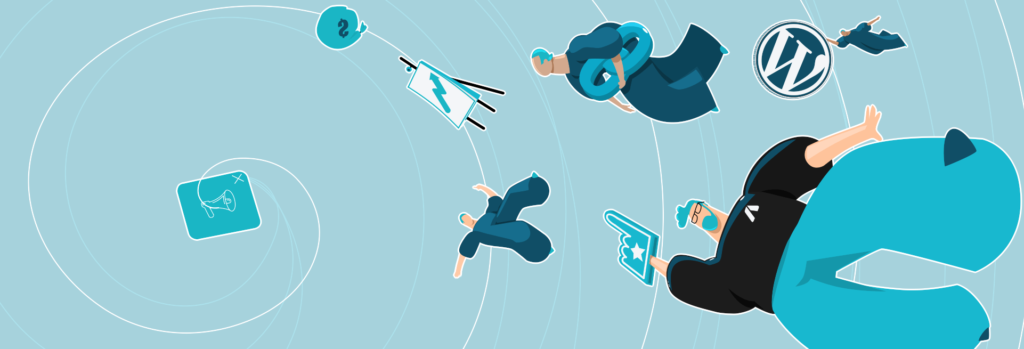Programmatic Advertising: An Ultimate Guide For Publishers
Programmatic advertising is a leading technique for buying and selling digital ads online. This form of advertising opened lucrative ways for publishers to monetize their digital content while advertisers could reach their target audience effectively and at scale.
In this ultimate guide for publishers, we will explore what programmatic advertising is, how it works, and why it has become so popular over the years.
What is Programmatic Advertising?
Programmatic advertising is the automated buying and selling of digital ad space. Before programmatic advertising, all the processes of ordering, setting up, and reporting ads had to be done manually.
Programmatic advertising uses AI and machine learning to make real-time buying and selling of ads instead of engaging in human negotiations and paying predefined prices.
Definition of programmatic advertising
Programmatic advertising can have multiple definitions depending on the situation in which it’s used. The textbook definition is: “automated buying and selling process of digital ads.”
However, when most industry professionals refer to this concept, they frequently mean the automated buying and selling of data-targeted media.
Data distinguishes these two definitions from one another.
Automation reduced the amount of time publishers, and advertisers were required to negotiate digital ad deals. But programmatic advertising now depends on adding data like ad performance, target audiences, and cross-domain behavioral data.
A brief history of programmatic advertising
Here are the 5 main points of programmatic’s development:
- 1994. The first static banner ad was created by HotWired (now known as Wired.com). It’s known as the earliest ancestor of the modern digital ad. Although this banner ad was not programmatic, its 468×60 size provided a foundation upon which advertisers build ads.

Source: Wired.com
- 1996. The first ad server, Double Click, was created and continues to supply ads today. It was bought by Google 11 years later for $3.1 billion.
- 2000. Google AdWords (now known as Google Ads) was introduced. It wasn’t the start of programmatic because AdWords only allowed advertising on Google’s network. It still was a huge milestone in the digital advertising world. AdWords brought more clarity to the digital ad world.
- 2003. Google launched its display ad network–AdSense. This platform enabled publishers to serve ads precisely targeted to the specific content of their web pages. There were other platforms in the ad sector, but because of its market cap, Google’s solutions were the most popular.
- 2007-2010. Ad exchanges such as Yahoo’s Right Media, Google AdEX, Microsoft AdECN, AdMeld, PubMatic, The Rubicon Project, and Open X began developing RTB software, which worked as a DSP, an SSP, an ad exchange, or a mix of the three.
- 2015. Matt Kendall and Paul Yang from AppNexus, with the help of Nick Jacob from the publisher Aplus, created Prebid.js. It was created as an alternative to the waterfall method. Afterward, Prebid increased the popularity of header bidding due to its simplicity and effectiveness, and since then has become the industry standard.
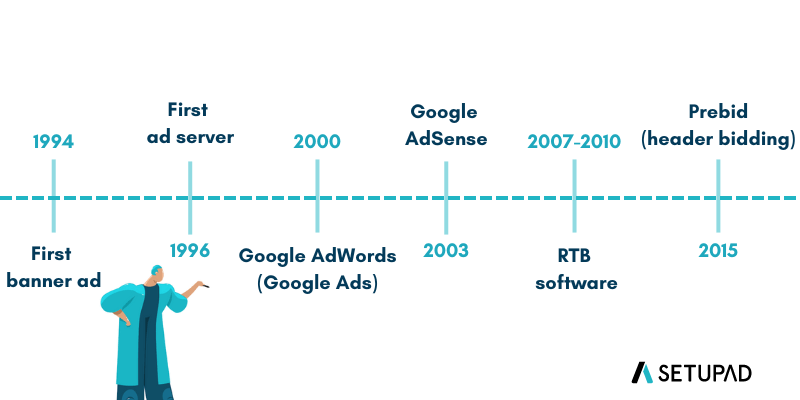
RTB platforms were beginning to flourish. DSPs and SSPs enabled advertisers to target their core customers directly, improve engagement metrics, and ultimately increase revenue.
From the first online banner ad through significant advancements in automation, the past years have been fascinating regarding programmatic innovation.
Importance of programmatic advertising in the current marketing landscape
The most recent data shows that programmatic advertising spending reached $418 billion in 2021. By 2026, this amount is anticipated to reach $725 billion.
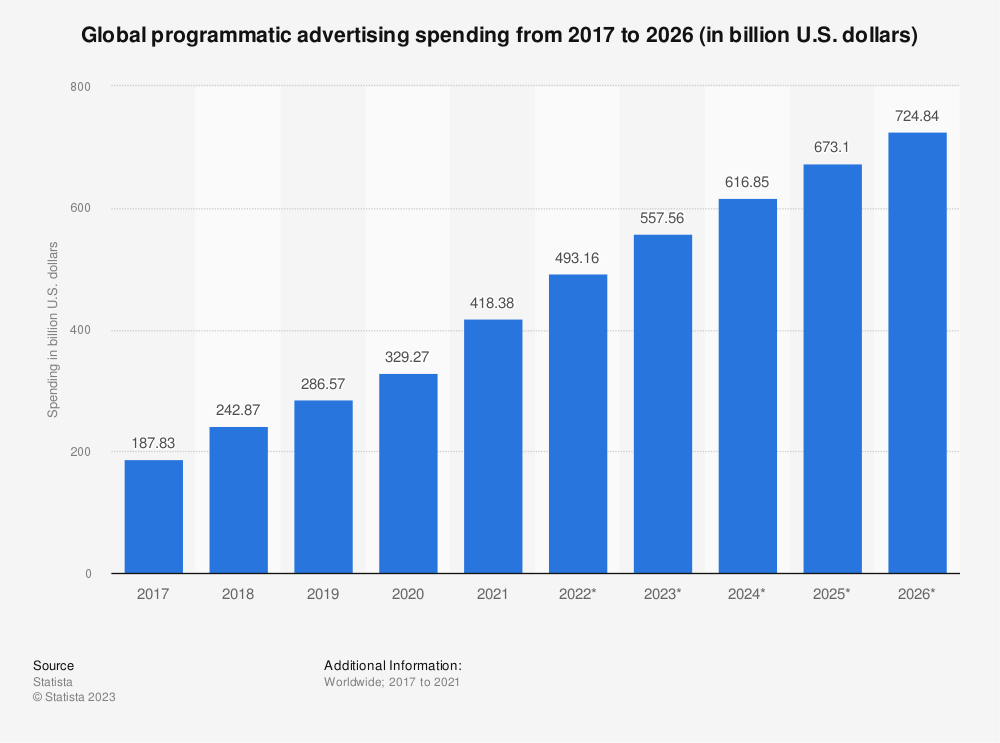
Source: Statista
Additionally, the U.S. was the largest programmatic advertising market in 2021, with an estimated spending of $167.1 billion, followed by China with $109.48 billion and the U.K. with $24.01 billion.
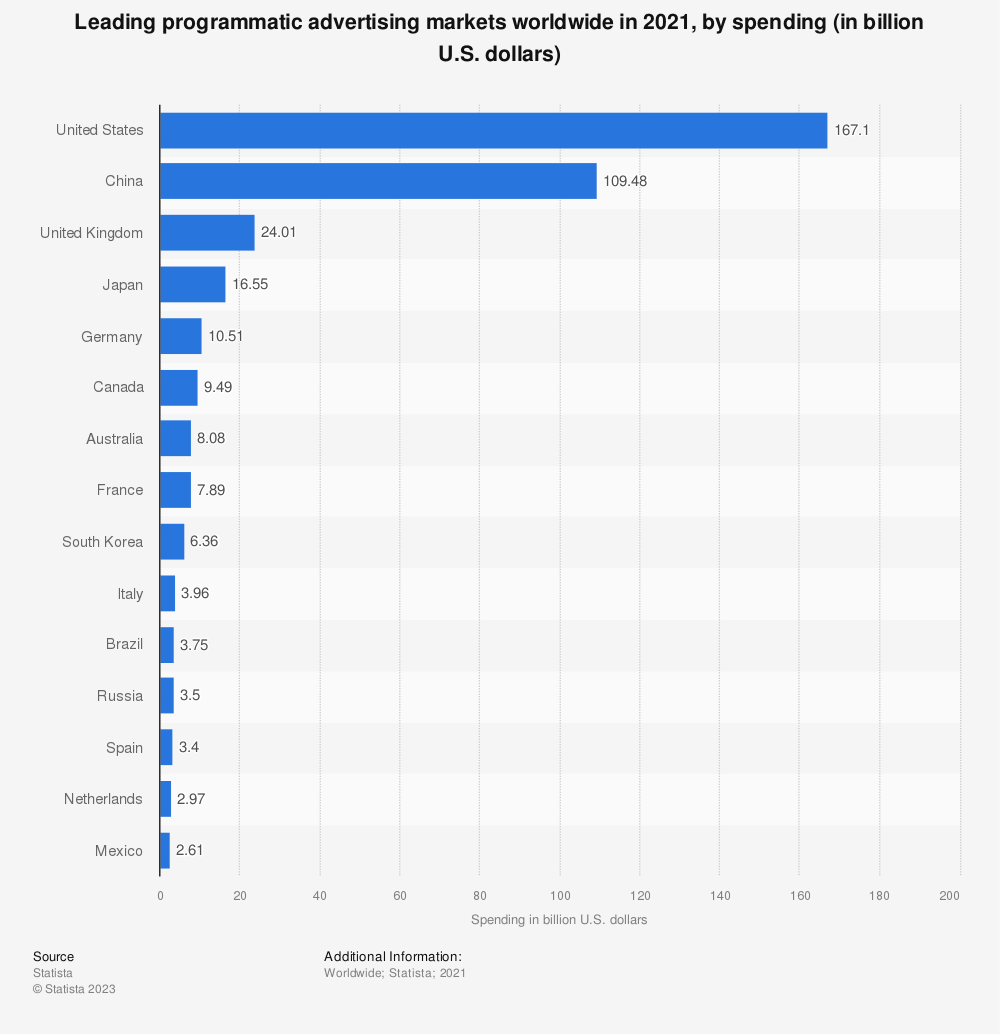
Source: Statista
Programmatic advertising is essential in the current advertising landscape because of its efficiency, targeting capabilities, improved ROI, and increased transparency and control.
It enables advertisers to precisely and effectively reach their target audience and benefits publishers by providing them with a more efficient way to sell ad space.
However, there are also some challenges.
According to a 2021 global survey, the main programmatic advertising challenge identified by 32% of respondents was connecting DSPs with other marketing tools.
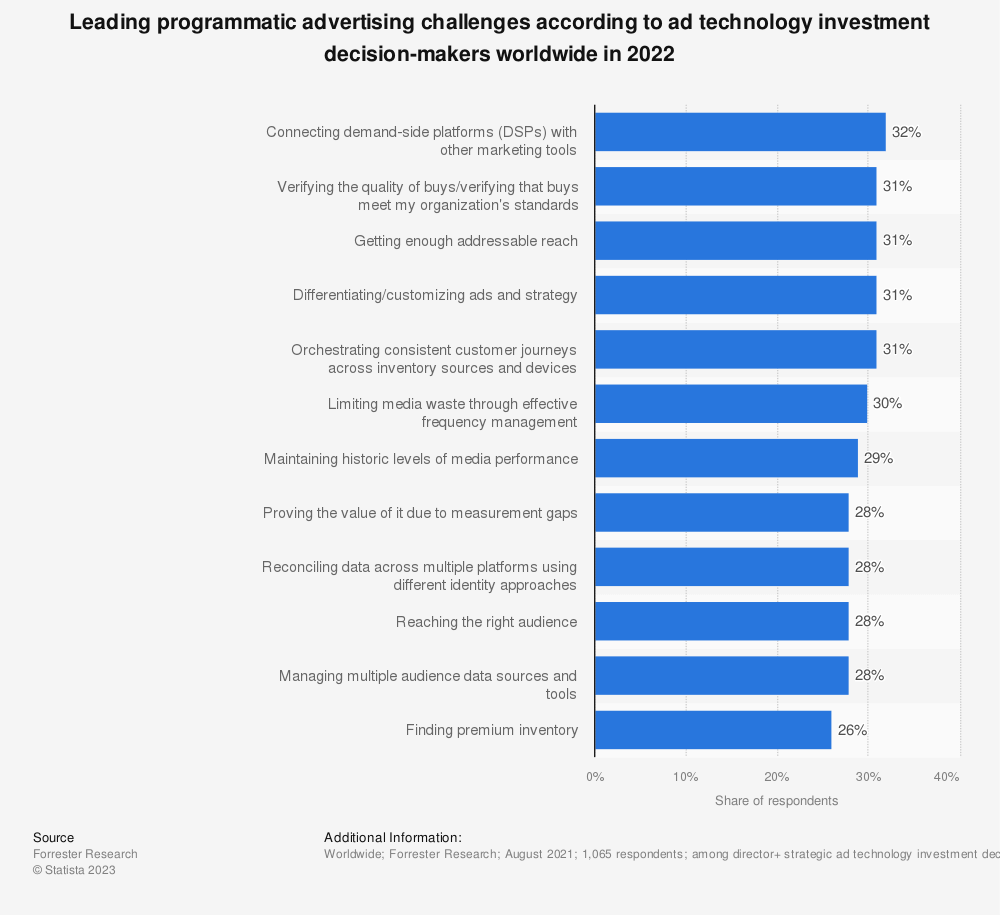
Source: Statista
Cookie deprecation brings another challenge to the programmatic advertising industry… In the near future, DSPs and SSPs won’t be able to share details about third-party cookies for frequency capping or to identify matches for ad relevance.
These systems must develop new ways to filter and match criteria between buyers and sellers.
It should go without saying that AI technology, packed with a complicated algorithm, is essential for ad efficiency considering the variety of options available to digital marketers.
Better targeting and creative methods, more scientific media evaluation, and data-driven marketing decisions are all elements that will continue to advance across all digital platforms. By improving data literacy skills, businesses can make more informed decisions based on data insights, optimize campaigns, and understand their audience better.
How Programmatic Advertising Works?
Here are the main 6 steps that simplify how programmatic advertising works:
- The publisher lists available ad space on an ad exchange using an SSP.
- A publisher’s website contains a pixel that sends data to a DMP about the website, the user, and the ad space.
- In the meantime, an advertiser configures their ads’ targeting and budget parameters using a DSP.
- To find inventory on the ad exchange that best suits the advertiser’s needs, the DSP connects with the DMP. Then a request is sent to the auction.
- The ad exchange selects an ad to match with each impression opportunity using algorithmic software.
- To display the ad to the user on the publisher’s website, the DSP sends it to the SSP.

Overview of the programmatic advertising ecosystem
Programmatic advertising has many moving parts. There are 4 main components that create a basic programmatic advertising ecosystem:
- Demand-side platform (DSP).
- Supply-side platform (SSP).
- Data management platform (DMP).
- An ad exchange.
What are the programmatic advertising platforms?
Programmatic platforms help with programmatic advertising. They can assist publishers in finding the right services and getting access to the right advertisers that match their needs.
For example, Google Ad Manager is a programmatic advertising platform working on the supply side to monetize publishers’ content. It’s an accessible platform with many tools and analytics for publishers to set up and serve ads.
Programmatic advertising platforms form a part of the complete programmatic advertising ecosystem. Each part of the system works together to help publishers and advertisers.
Some of the types of platforms include the above-mentioned four main components–DSPs, SSPs, DMPs, and ad exchanges.
Role of demand-side platforms (DSPs)
Demand-side platforms (DSPs) enable advertisers to purchase publishers’ digital ad space automatically through ad exchanges.
In the DSP, the advertiser configures their preferences for audience targeting and ad inventory. The platform automatically searches the ad exchange or network for opportunities that fit these criteria and selects the best price for ad impressions.
Demand-side platform companies like Google Display & Video 360, Xandr, MediaMath, and Adobe Advertising Cloud are one of the most popular DSPs in the ad tech industry.
- How do DSPs work?
Demand-side platforms allow advertisers to identify and pick their target audience and submit the ads they want to publish.
Publishers use ad exchanges and SSPs to make their ad inventory accessible to the DSP.
These platforms provide the ad impressions to the DSP, which decides whether to send a bid depending on how well it matches the targeting parameters.
Advertisers compete for the ad impression by making real-time bids. The ad is displayed on the publisher’s website after the DSP buys the impression.
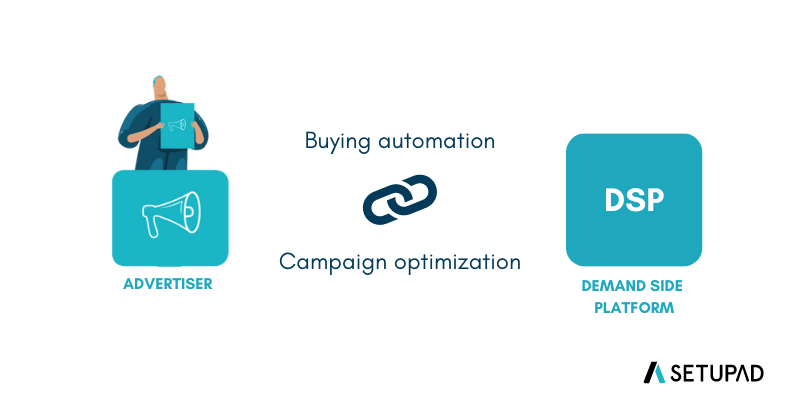
Role of supply-side platforms (SSPs)
A supply-side platform (SSP) is software for publishers that enables them to offer their ad space for purchase anytime.
Publishers can reach a large audience with SSPs without having to approach each advertiser individually and adjust their price points dynamically.
Some of the most popular SSP companies are OpenX, Xandr, and PubMatic.
There are companies (e.g., Xandr) that combine SSP and DSP. Some even integrate an SSP, a DSP, and a DMP (e.g., Adform).
- How do SSPs work?
Publishers automate the selling of their digital ad inventory using SSPs.
With an SSP, a publisher offers its available ad inventory. An ad request is sent to multiple ad networks, ad exchanges, and occasionally DSPs each time the publisher’s webpage loads.
Several DSPs place bids on the impression that the publisher offers in real-time bidding. The winning bid is then transmitted through the SSP to the website, where it is shown to the user.
The SSP gathers information on ad performance and transmits it to the selected platform to host the ads.
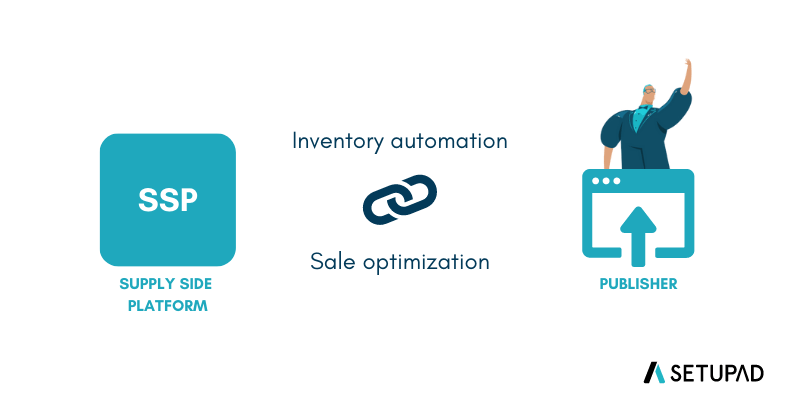
The difference between a DSP and an SSP
The main difference between DSPs and SSPs is that DSPs allow advertisers to buy ad impressions across many publishers’ websites efficiently.
In contrast, an SSP allows publishers to sell their ad inventory to advertisers at the highest possible price.
| SSP | DSP | |
| End-users | Publishers | Advertisers |
| Purpose | Enables publishers to sell their ad inventory across different ad exchanges | Enables advertisers to buy ad space across several different ad exchanges simultaneously |
| Functions | Runs a real-time auction, serves the ad, and brings together inventory, multiple ad networks, ad exchanges, and DSPs. | Helps advertisers to leverage audience targeting and optimize various campaigns. |
Advertisers and publishers are brought together through DSPs and SSPs, allowing the first group to purchase ad space from the other.
Users of DSPs benefit by having access to scalable, direct solutions for reaching a particular target audience at the ideal time, location, and inside the ideal context.
Users of SSPs are getting access to software that enables them to manage their digital ad inventory and monetize their ad space.
Role of data management platforms (DMPs)
Data management platforms (DMPs) help to gather, arrange, and analyze data. This information can come from the ad buyer’s first-party and third-party data sources.
On the publisher’s side, this might contain both on-site behavioral and first-party data from their users.
DMPs can leverage the data sources to produce anonymized profiles that DSPs and SSPs can employ.
To improve targeting when matching ad space, an ad buyer would build a profile of their desired target demographic and use that information through their DSP.
Additionally, publishers develop anonymized user profiles to help buyers find an appropriate match through their SSP.
DMP examples include Nielsen, Lotame, Oracle, and Salesforce Audience Studio.
What’s an ad exchange?
Ad exchanges sit in the middle of the programmatic ecosystem. It’s where DSPs and SSPs meet to negotiate a price and trade inventory.
Note that ad networks and ad exchanges are frequently confused.
An ad network is a platform that collects and offers inventory from various in-network publishers.
An ad exchange is a technology platform where buyers and sellers connect to sell and purchase ad inventory.
Real-time bidding (RTB) process
In real-time bidding, ad space is sold through an auction process in real-time.
Advertisers place bids on the advertising space they are interested in, and the winning bid receives the ad space.
This process happens in milliseconds and is facilitated by the programmatic technology.
Real-time bidding relies on data and algorithms to automate buying and selling of ad space. Advertisers use data on their target audience to inform their bidding strategies, and programmatic technology uses this data to match ads with the most relevant audience.
Programmatic Video Advertising
Programmatic video advertising is a format used within the programmatic advertising world.
Video ads reach potential clients wherever they view the video content–before streaming a TV show or while reading a blog. Programmatic video advertising can establish an emotional bond between the brand and its audience.
Mobile Programmatic Advertising
Mobile programmatic advertising has completely changed how buyers and sellers engage in mobile advertising. It’s one of the fastest-growing segments of marketing and advertising globally.
Mobile programmatic advertising, at its most basic, is the automation of the purchasing and selling of digital ads inside ad exchanges and inventories.
RTB is the most popular and widely used form of programmatic mobile advertising.
OTT Advertising
OTT stands for over-the-top, which means using an internet connection instead of traditional cable or satellite to receive content.
Therefore, OTT advertising is the practice of marketing to this online audience while streaming TV, mobile, desktop, tablet, or laptop content.
Programmatic TV
Programmatic TV (PTV) is a digital solution that uses data-driven algorithms to improve marketing efficiency in the television segment.
The 5 main benefits of PTV include:
- Scaling audience reach.
- Improving brand recognition.
- Raising the value of first-party data.
- Creating a more accurate marketing strategy.
- Increasing the revenue.
PTV is replacing the traditional cable TV ad model because it offers better targeting and enhances the whole ad campaign strategy.
Programmatic Advertising Auction Types for Buying and Selling
There are two main auction types of programmatic advertising–first-price and second-price auctions.
In both first-price and second-price auctions, multiple bidders participate by sending in their bid prices, and the highest bid wins. The difference is how much the winning bidder has to pay.
In a first-price auction, the winning bidder pays an amount equal to its bid price. So, the highest bidder pays what they bid exactly.
In a second-price auction, the winning bidder pays an amount that’s one cent more than the bid price of the second highest bidder.
Source: Google
Below you can see the different types of programmatic deals available.
Header bidding
Header bidding is a programmatic technology in which publishers simultaneously offer their ad inventory to many demand partners (e.g., Google).
Enabling multiple demand partners to bid on the same ad inventory creates more competition. Therefore it allows publishers to sell their ad inventory for the highest price.
Exchange bidding
Exchange bidding, also known as Open Bidding or EBDA, is Google’s server-to-server header bidding technology that enables publishers to invite multiple third-party ad exchanges in an auction for their ad inventory.
The server-side unified auction happens in the ad server instead of the user’s browser, which improves the page loading speed and benefits Google’s Core Web Vitals scores.
With Open Bidding, demand partners compete in real-time bidding on a first-price basis against GAM line items in dynamic allocation.
Real-time bidding
Real-time bidding (RTB) is how advertisers compete for ad spaces in an online auction in real-time. Transactions are completed within the time it takes to load a webpage (less than a second).
RTB is often conducted using a cost-per-thousand impressions (CPM) pricing model. As a result, relevant advertisers compete for inventory to reach publishers’ audiences, and the open spots go to the ones with the highest CPMs.
Both sides can provide the parameters they’re looking for in an RTB system, including audience type, bid range, ad format, etc.
Private marketplace
Private marketplace (PMP) is an auction with a limited number of advertisers selected by the publisher. PMPs fall under real-time bidding and offer more ad placement control.
Private marketplace offers can benefit publishers and advertisers because they often provide premium ad space deals.
Programmatic guaranteed
Programmatic guaranteed enables publishers and advertisers to directly negotiate the deal’s terms reserved for that specific advertiser.
The publisher then agrees to sell a fixed number of impressions to the buyer for a fixed price. Buyers can preview placements and choose which ones they want to buy.
Despite not being an auction, programmatic guaranteed is considered a highly cost-effective method of media selling.
Preferred deals
Preferred deals don’t have an automated auction process. Publishers offer their ad inventory to selected advertisers at a negotiated fixed CPM. Advertisers have the chance to preview the inventory before they decide to buy it.
Once both parties have reached an agreement, the buyer gets a ”preferred” opportunity to bid on that inventory when there’s an ad request.
Open auction
The open auction, also known as real-time bidding (RTB), is the most popular form of programmatic auction. In an open auction, publishers allow hundreds of demand partners through SSPs to bid on their inventory simultaneously.
As a result, publishers can achieve maximum yield.
Publishers set a minimum floor price per thousand ad impressions (CPM), and the highest bidder wins the impressions.
Benefits of Programmatic Advertising
There are 5 key benefits of programmatic advertising.
Increased efficiency and speed
Programmatic advertising automates the buying and placement of online ads, making the process faster and more efficient. It’s more accurate and efficient since no human factor is involved.
Better targeting capabilities
Programmatic advertising uses data and algorithms to target the right audience at the right time, leading to better ad engagement and conversions.
Improved ROI
Advertisers can measure the success of their campaigns in real-time, improving their return on ad spend. For publishers, programmatic advertising allows to manage and organize their ad placements across all programmatic channels.
Increased transparency
Programmatic advertising provides advertisers with tools to measure and optimize the effectiveness of their ad campaigns through bid-level data. This data can include information such as the cost per impression (CPM), the bid amount, and the targeting criteria used for a given advertising campaign.
Publishers, on the other hand, are equipped with information about the buying process, including which advertisers are bidding on inventory and at what price.
Scalability
Programmatic advertising is highly scalable. The use of automated technology and algorithms allows programmatic advertising to efficiently target and deliver ads to large audiences at scale, reducing the manual effort required to execute and manage campaigns.
Challenges of Programmatic Advertising
Ad fraud
Ad fraud is a significant threat in programmatic advertising. It typically involves various practices that are used to inflate traffic, generate false impressions or clicks on ads, and more.
However, there are various initiatives, like ads.txt, sellers.json, and SupplyChain Object that have been developed over the years to combat ad fraud and increase the transparency of the programmatic supply chain by revealing where impressions are purchased and resold.
Privacy concerns
Programmatic advertising raises privacy concerns because it involves the collection, use, and sharing of personal data. The findings of research conducted by Google and Ipsos have found that users perceive a bad privacy experience as a theft of personal data.
Therefore, privacy regulations and guidelines, such as the European Union’s General Data Protection Regulation (GDPR) and the California Consumer Privacy Act (CCPA), have been introduced. Still, there is a lot of conversation about how to safeguard user privacy while keeping targeted ads.
Lack of transparency in the supply chain
Programmatic auction consists of many moving parts and middlemen. Therefore, lack of transparency tends to be the top problem. Moreover, a complicated supply path involves more hidden fees and charges that are impossible to attribute.
Programmatic Advertising Costs
The pricing model of programmatic advertising can vary depending on the specific platform, type of inventory, and advertising objectives. The following are some of the most common pricing models used in programmatic advertising:
- Cost per impression (CPM): Publishers get paid a fixed price for every 1,000 impressions (views) of the ad on their website. This pricing model is commonly used for branding and awareness campaigns.
- Cost per click (CPC): Publishers get paid a fixed price every time someone clicks on the ad on their website. This pricing model is commonly used for performance-driven campaigns where the goal is to drive traffic to a website or other destination. The most popular ad network where this pricing model is utilized is Google AdSense.
- Cost per action (CPA): Publishers get paid a fixed price for a specific action, such as a sale or lead generation, generated by users from the ad on their website. This pricing model is commonly used for campaigns with a specific conversion goal.
We’ll focus on CPM because it is the most common pricing model and is also utilized in header bidding.
CPM Formula
The formula for CPM is the total cost of an ad campaign divided by the number of ad impressions and multiplied by 1000.
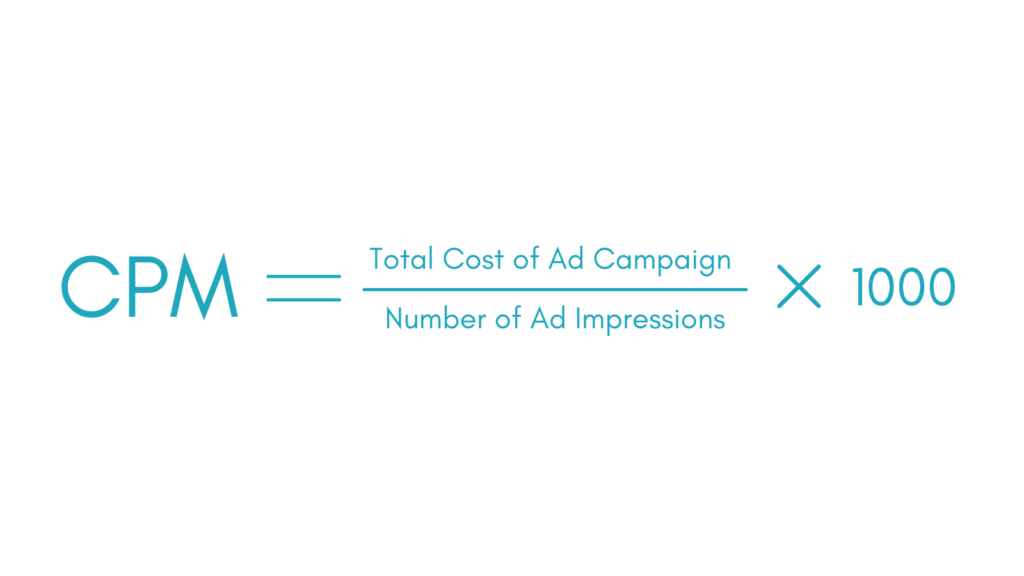
How to calculate CPM?
Let’s look at the example to make the CPM calculation formula more understandable.
Suppose the publisher earned 1000€ by selling 1M ad impressions to a particular advertiser. The calculated CPM would be 1€. This means that the publisher will earn 1€ for every 1000 ad impressions he sells to that advertiser.
(1000€ / 1M) x 1000 = 1€ (CPM)
Remember that the CPM for specific niches or websites can vary greatly based on traffic geolocation, ad viewability, ad quality, audience engagement, competition, etc.
Programmatic Advertising for Publishers
Programmatic advertising is important for publishers because it offers a more efficient, automated, and data-driven way to sell and manage advertising inventory.
Programmatic services allow publishers to effectively segment their diverse audience through automation offered by ad platforms. This provides easy monitoring of all advertisements and their placement’s impact on user engagement.
Programmatic enabled advertisers to target relevant audiences on any publisher’s platform, boosting demand for the publisher’s traffic and improving ad revenue.
Best Practices for Programmatic Advertising
Programmatic advertising vs digital advertising
Programmatic advertising refers to using software to automate the buying and selling of advertising space. Digital advertising, on the other hand, refers to any form of advertising that uses the Internet and digital technologies to reach consumers, a distinction that often comes up in discussions of marketing versus advertising. This can include programmatic advertising and other forms of online advertising, such as display ads, social media advertising, and search engine advertising.
Importance of data management
In programmatic advertising, data informs the real-time bidding algorithms that decide which ads to show to which users. The data used in programmatic advertising can come from various sources, including cookies, device IDs, and third-party data identifiers. To handle, organize, and use all this data, publishers frequently turn to data management platforms.
To ensure compliance with various privacy legislations, Consent Management Platforms (CMP) must be used on publishers’ websites that comply with the IAB’s Transparency and Consent Framework (TCF).
Proper setup of programmatic advertising campaigns
To start with programmatic advertising, advertisers first need to research, set goals, and determine their creative strategy. This involves setting KPIs, choosing the right creative medium, such as banner ads, video ads, native ads, and in-app ads, and choosing a demand-side platform (DSP) responsible for controlling and optimizing ad spend.
Publishers, on the other hand, should begin by optimizing their websites and determining their monetization goals. A logical next step is to partner with a monetization platform like Setupad to get a better return on their inventory.
Regular monitoring and optimization
Regularly monitoring and optimizing your campaigns is a crucial step in programmatic advertising, which publishers often outsource to a trusted monetization partner. Optimizations can help identify areas for improvement, such as underperforming ad formats or ad placements, poor fill rate, ad viewability, and price floor management.
For advertisers, this step is equally important to ensure that ads are served to the right audience at the right time and with the right message. This can increase engagement, conversions, and ROI.
The Future of Programmatic Advertising
Artificial intelligence (AI)
Artificial intelligence (AI) is responsible for various crucial parts of programmatic advertising, such as:
- Bid optimization: AI algorithms can determine the optimal bid for each ad impression based on factors such as the target audience, the relevance of the ad, and the likelihood of conversion.
- Price floor optimization: AI and machine learning algorithms can analyze and find the optimal price floor to optimize publishers’ long-term revenue.
- Smart ad refresh: Smart ad refresh takes into account user behavior to refresh only viewable impressions, therefore benefitting the publisher.
- Ad placement: AI algorithms can determine the best placement for each ad, based on factors such as viewability, engagement rates, and historical performance data.
- Fraud detection: AI algorithms can identify and prevent fraudulent activity, such as bots simulating clicks or impressions, which can undermine the effectiveness of an advertising campaign.
This is not an exhaustive list. AI is also used widely in other parts of programmatic advertising, such as content personalization, audience targeting and segmentation, and much more. As AI gets more advanced and the industry strives for more automation, we expect AI to continue to drive innovation by leveraging advanced techniques such as deep learning, natural language processing, and computer vision.
Increased personalization with dynamic creative optimization (DCO)
Dynamic Creative Optimization (DCO) is a type of programmatic advertising that focuses on creating unique ads for each customer. This is especially useful for product retargeting, where customized ads can be created to show products that customers have viewed or interacted with previously.
In a DCO setup, a CMP acts as a central repository for the data that drives the optimization, such as customer profiles, browsing history, purchase history, and demographic information. This data is then used by the DCO algorithms to determine which version of the ad to display to each individual viewer.
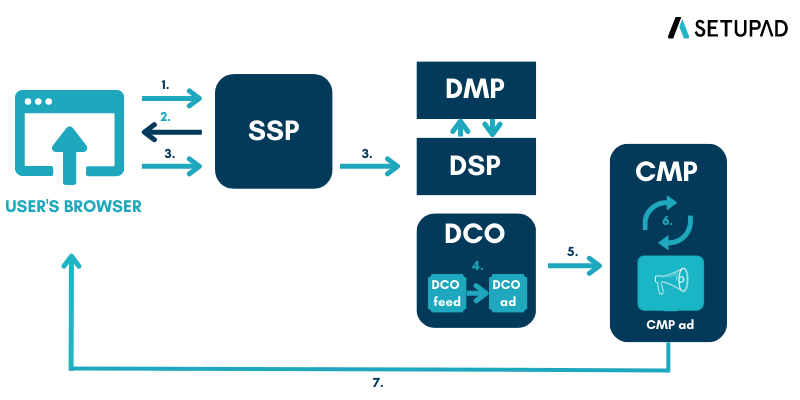
Third-party cookies
The future of third-party cookies in programmatic advertising is uncertain, as privacy regulations and industry trends are pushing toward more privacy-focused solutions.
Industry thought leaders seem to agree that the open web will be affected by the demise of third-party cookies by 2024.
However, one thing remains clear, first-party data will be crucial for both publishers and advertisers moving forward. Identity solutions, such as data clean rooms, may not be enough to replace the tracking capabilities of third-party cookies.
Setupad Solution for Publishers
Setupad offers a programmatic advertising technology to publishers called header bidding. Header bidding, also known as pre-bidding or prebid, enables publishers to simultaneously offer their ad inventory to many demand partners like Google through supply-side platforms (SSPs) and ad exchanges.
This pushes the competition between demand partners and can grow publisher’s revenue by at least 30% over a popular Google AdSense. In addition, you’ll benefit from full technical support from our experts, advice on choosing the best-performing ad placements and sizes, protection from malvertising, and recommendations tailored to your website.
Conclusion
Programmatic advertising uses data insights and algorithms to serve ads to the right user at the right time and at the right price. It simplifies and fastens the ad buying and selling process.
Programmatic has changed the way publishers and advertisers communicate, how they target audiences and evaluate the effectiveness of ad campaigns for the better.
As cookie deprecation presents programmatic advertising with a new challenge and different AI tools (e.g., ChatGPT) enter the market, the upcoming years will surely bring additional changes and improvements to the industry.
FAQ
1. What are the 4 main components of programmatic?
The four main components of programmatic advertising are:
- Data Management Platform (DMP)
- Supply Side Platform (SSP)
- Demand Side Platform (DSP)
- Ad Exchange.
2. What is the difference between Google Ads and programmatic?
With Google Ads, you may serve your ads on the Google Display Network, a collection of over two million websites that reach over 90% of Internet users across the globe.
On the other hand, programmatic advertising isn’t limited to a single inventory provider. It gives access to Google’s advertising and other ad exchanges, such as AdForm, AppNexus, Rubicon Project, and Amazon.
3. What is the difference between PPC and programmatic?
Programmatic advertising is the automated process of buying and selling ads online.
PPC (Pay-Per-Click) is an advertising model, in which an advertiser has to pay a certain amount every time a user clicks on their ad.
PPC advertising offers more control over the targeting and placement of your ads, while programmatic advertising is more efficient and automated.
4. What is programmatic advertising and how does it work?
Programmatic advertising uses artificial intelligence and machine learning to make real-time buying decisions for display of digital ads.
5. What does DSP mean in programmatic?
Demand-side platforms (DSPs) enable advertisers to purchase publisher’s digital ad space automatically through ad exchanges.
6. What is DSP vs SSP?
DSPs allow advertisers to buy ad impressions across many publishers’ websites efficiently. An SSP allows publishers to sell their ad inventory to advertisers at the highest possible price.
7. How does programmatic advertising increase the efficiency and accuracy of targeting audiences?
The data-driven, real-time, and algorithmic nature of programmatic advertising helps to make targeting much more efficient and accurate than traditional forms of advertising. It allows advertisers to reach their target audience more effectively and achieve their marketing goals.
8. What is header bidding and how does it relate to programmatic advertising for publishers?
Header bidding is a crucial component of programmatic advertising. It allows publishers to maximize their revenue potential by offering their ad inventory to multiple demand sources and receiving the best possible return for each impression.
9. How to measure programmatic advertising?
Impressions measure the number of times an ad has been served to users. It’s a basic metric used to determine the reach of a campaign.
Clicks measure the number of times a user has clicked on an ad. It’s a useful metric for determining the interest and engagement of users with the ad.
Click-through rate (CTR) is calculated by dividing the number of clicks by the number of impressions. CTR is a key metric used to determine an ad’s effectiveness in driving user engagement.
Conversion rate measures the number of users who have taken a desired action, such as making a purchase, after clicking on an ad. It’s a crucial metric for determining a campaign’s effectiveness in driving business results.
10. What is programmatic native advertising?
Programmatic native advertising is a form of digital ads that blend in seamlessly with the content on a publisher’s site or app.
Native ads are designed to match the look and feel of the surrounding content. This makes them less intrusive and often more engaging for users compared to other forms of advertising.
